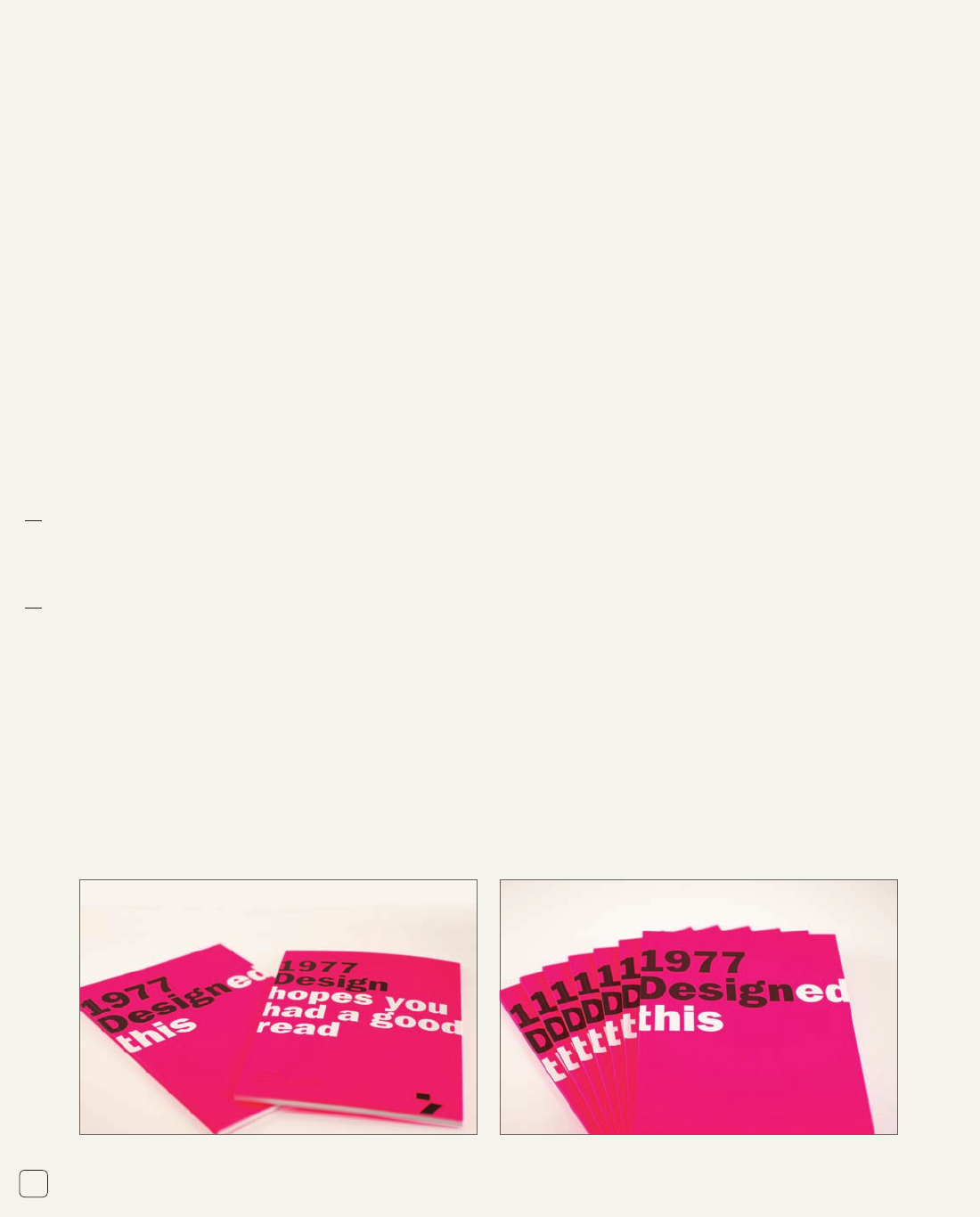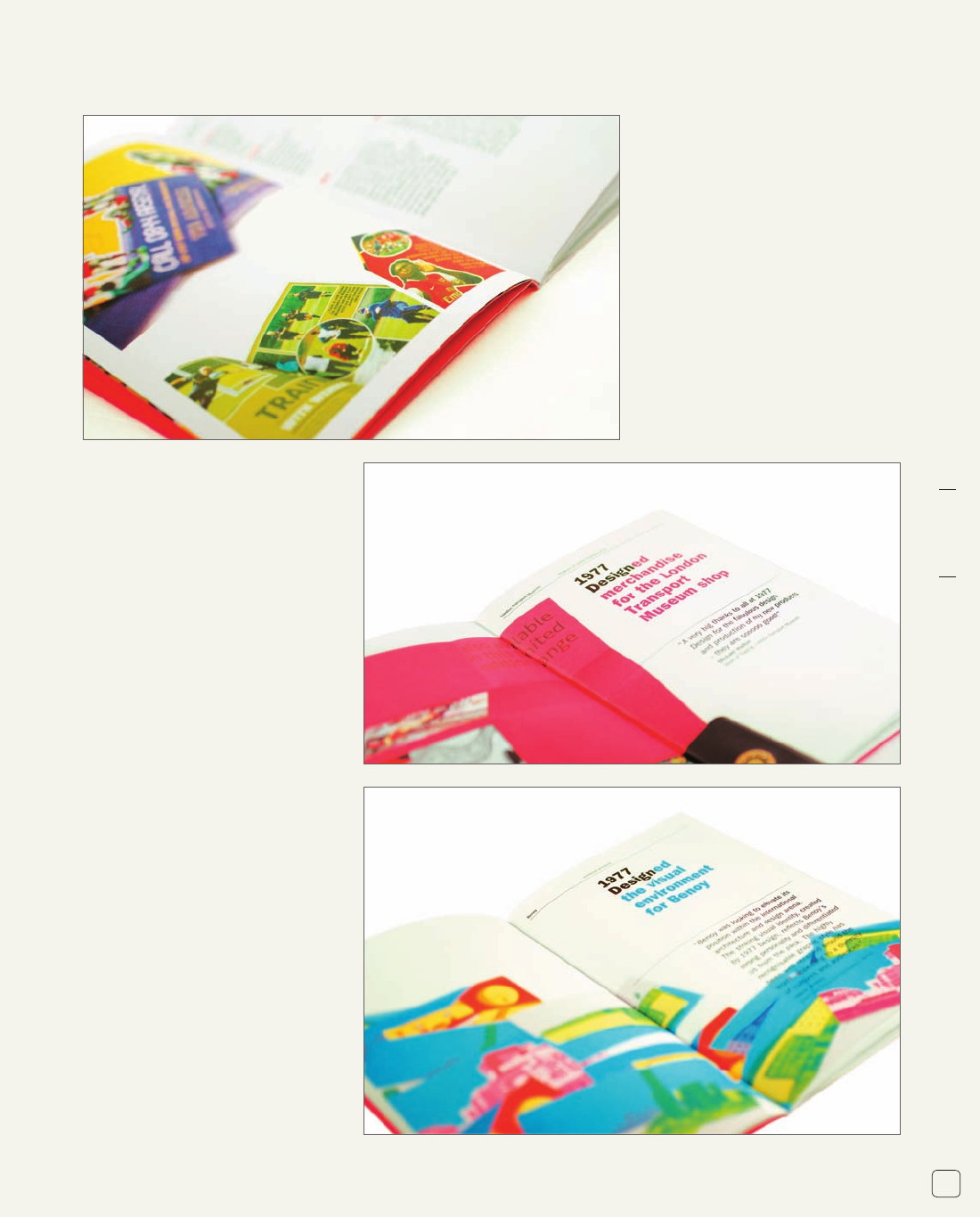
Job:11-15877/15287 Title:RP-Design Matters Portfolios
#175 P DTP:216 Page:44
(RAY)
Job:11-15877/15287 Title:RP-Design Matters Portfolios
#175 P DTP:216 Page:45
001-093_15877.indd 45 11/30/09 3:20:6 PM
D E S I G N M AT T E R S / / P O R T F O L I O S 0 1
45
Text
p l a n n i n G c R E A T I N G i m p l e m e nt i n G
To find work, you must look for it actively. This means promoting yourself. “I’m
not a salesperson,” you might insist. But the truth is, to grow your business,
you’re forced to wear a sales hat. You need to talk about your company and
what you do. You have to be the walking, talking billboard of your company, with
your portfolio in hand.
Experts agree that you need to structure your portfolio’s content so that it is the
most meaningful to those whom you have identified as your key audience. Strive
for brevity, while also telling a story. For viewers who want more details, provide
expansive case studies of your work.
Lather, Rinse, Repeat
TAK E A GOOD LOOK AROUND.
WHAT DO YOU SEE?
Job:11-15877/15287 Title:RP-Design Matters Portfolios
#175 P DTP:216 Page:44
(RAY)
Job:11-15877/15287 Title:RP-Design Matters Portfolios
#175 P DTP:216 Page:45
001-093_15877.indd 45 11/30/09 3:53:29 PM

(RAY)
Job:11-15877/15287 Title:RP-Design Matters Portfolios
12-C54244 (204) #175 P DTP:216 Page:46
001-093_15877.indd 46 12/16/09 2:52:32 PM
46
D E S I G N M AT T E R S / / P O R T F O L I O S 0 1
Text
Here’s where the tough part comes
in. Engage with your audience and
determine what is working and what
is not. What information should you
have in your portfolio and what can
be omitted? Let’s face it: every person
is different and their response to
your portfolio or self-promotion may
be different from the next guy’s.
But if there is a consistent thread
of discontent with your portfolio—
such as not enough visuals or your
copy does not meld with the visual
creativity you espouse—pay atten-
tion. If you are repeatedly asked for
clarifying information after a recipient
has viewed your portfolio, take note
and make the appropriate changes
that will garner the response you are
looking for.
When evaluating your vision for your portfolio, ask yourself:
When your audience looks at your portfolio or self-promotion piece, do they quickly find what they are looking for? Are
they engaged with what they see? In general, most don’t, and they back out faster than they would when they leave a
bad movie.
Most expert advice on portfolio design
can be summed up in a single word—
simplicity. This may sound almost trite,
but simplicity is key when it comes to
developing a consistent, memorable
portfolio or self-promotion.
In addition to simplicity, a well-thought-
out portfolio strategy will go a long
way. As in the early world of comput-
ing, it was often said that a computer
is only as good as the programmer—
“garbage in, garbage out”; the same
can be said of portfolio design.
The bottom line? A focused, powerful
portfolio will set you apart from the
competition, break through the clutter,
accelerate relationship-building, and
dramatically improve your probability
of success.
Streamlined for Success
KISS—K EEP IT S I MPLE, STUP I D
p l a n n i n G c R E A T I N G i m p l e m e nt i n G
(RAY)
Job:11-15877/15287 Title:RP-Design Matters Portfolios
#175 P DTP:216 Page:46
001-093_15877.indd 46 11/30/09 3:53:29 PM

(RAY)
Job:11-15877/15287 Title:RP-Design Matters Portfolios
12-C54244 (204) #175 P DTP:216 Page:47
Job:11-15877/15287 Title:RP-Design Matters Portfolios
12-C54244 (204) #175 P DTP:216 Page:46
001-093_15877.indd 47 12/16/09 2:52:52 PM
D E S I G N M AT T E R S / / P O R T F O L I O S 0 1
47
Text
√π®
1977 Design created their portfolio
showcasing nine case studies that
demonstrate the skill sets of the studio.
Instigating dialogue and engaging with
the recipient was the drive behind the
portfolio design, as they looked to use this
as an opportunity to express the studio’s
personality and ethos. “An approachable tone
of voice was created that used the logo as
the lead-in for all headlines of the brochure,”
says Richard Stevens, designer at 1977
Design. The company name was given a
variety of suffixes to create the headlines.
“Client testimonials were featured next to
each project, breaking down the barriers that
design fluff sometimes creates,” Stevens
says. “This allowed us to communicate our
design approach in a manner that wasn’t
arrogant or mundane, focusing on engaging
the recipient. The ‘1977 Designed this’ line
is now used as a crediting logo for any work
coming out of the studio.”
1977 de S i G n
p l a n n i n G c R E A T I N G i m p l e m e nt i n G
Job:11-15877/15287 Title:RP-Design Matters Portfolios
#175 P DTP:216 Page:46
(RAY)
Job:11-15877/15287 Title:RP-Design Matters Portfolios
#175 P DTP:216 Page:47
001-093_15877.indd 47 11/30/09 3:53:29 PM

(RAY)
Job:11-15877/15287 Title:RP-Design Matters Portfolios
#175 P DTP:216 Page:48
001-093_15877.indd 48 11/30/09 3:20:27 PM
48
D E S I G N M AT T E R S / / P O R T F O L I O S 0 1
Text
Portfolio Must-Haves
KNOW ING WHEN TO STOP AND WHEN TO GO
Jeff Fisher, founder of LogoMotives
and author of The Savvy Designer’s
Guide to Success: Ideas and Tactics
for a Killer Career, provides insights
for creating that perfect portfolio.
Be creative! That’s now your job.
Don’t simply present potential
employers with a standard student
portfolio. When portfolios from local
schools are reviewed, many contain
the same class projects and begin to
look exactly the same. Incorporate
some individual projects—perhaps
some real-world work for a nonprofit
organization in which you have
a strong personal belief.
Keep actual book size manageable.
A large and unwieldy portfolio case
is going to make for an awkward and
less-than-favorable first impression
with an interviewer. Keep it small,
concise, and manageable so as to not
knock items off the desk of a portfolio
reviewer.
Be concise.
Maintain a limited number of pieces in
your book and make sure the work is
your BEST. Include unique pieces that
showcase your talents and skills. Most
creative directors and art directors will
not have much time to review a large
amount of your work. Showcase your
very best work first, keep the number
of included projects small, and make
the most of the time you are given for
the presentation.
Have a fine-tuned spiel.
Saying “and then I designed this,
and then I designed this…” as you
turn the pages of your book will not
make a great impression. Clearly
explain the brief, your process,
and any defined results for each
project included. Having a process or
sketchbook available for review is a
great idea. Practice your presentation
with friends, family, or student peers
before a presentation for a comfort-
able and polished presentation.
Be honest about your work.
Be up front about your participation
in any collaborative project effort
rather than claiming full credit for the
job. Show only your own work in your
book. You will be caught if attempting
to misrepresent yourself. The design
community makes up a very small
world.
Make use of online portfolios.
The Internet provides incredible—and
often free—resources for showcasing
your work and creating easily acces-
sible websites.
Social networking is your
self-promotion/marketing friend.
Many of the current Internet social
networking/media sites provide great
opportunities to network with potential
employers and showcase your work in
a gallery.
p l a n n i n G c R E A T I N G i m p l e m e nt i n G
(RAY)
Job:11-15877/15287 Title:RP-Design Matters Portfolios
#175 P DTP:216 Page:48
001-093_15877.indd 48 11/30/09 3:53:29 PM

Job:11-15877/15287 Title:RP-Design Matters Portfolios
#175 P DTP:216 Page:48
(RAY)
Job:11-15877/15287 Title:RP-Design Matters Portfolios
#175 P DTP:216 Page:49
001-093_15877.indd 49 11/30/09 3:20:27 PM
49
D E S I G N M AT T E R S / / P O R T F O L I O S 0 1
Text
P L A N N I N G
C R E A T I N G
I M P L E M E N T I N G
The Creative Group surveyed 250 advertising and marketing executives about what they expect in a portfolio. See if
you know the answers.
1
What is the percentage of
executives polled who value
overall creativity most when
evaluating a portfolio?
Answer:
2
What is the average number of
items executives recommend
should be included in a portfolio?
Answer:
3
What is the number of samples
typically viewed before determin-
ing whether someone is qualified
for the job?
Answer:
4
What is the number of people
within a firm who typically eval-
uates a candidate’s portfolio
before a job offer is extended?
Answer:
5
What is the number of work
samples that executives expect to
see in an online portfolio?
Answer:
6
What is the percentage of execu-
tives who, on average, spent five
minutes or less reviewing online
work?
Answer:
TEST YOUR KNOWLEDGE
Portfolio Expectations
A N S W E R K E Y :
1
69
2
11
3
9
4
3 or more
5
9
6
33
Job:11-15877/15287 Title:RP-Design Matters Portfolios
#175 P DTP:216 Page:48
(RAY)
Job:11-15877/15287 Title:RP-Design Matters Portfolios
12-C54244 (204) #175 P DTP:216 Page:49
001-093_15877.indd 49 12/16/09 3:01:32 PM
..................Content has been hidden....................
You can't read the all page of ebook, please click here login for view all page.
